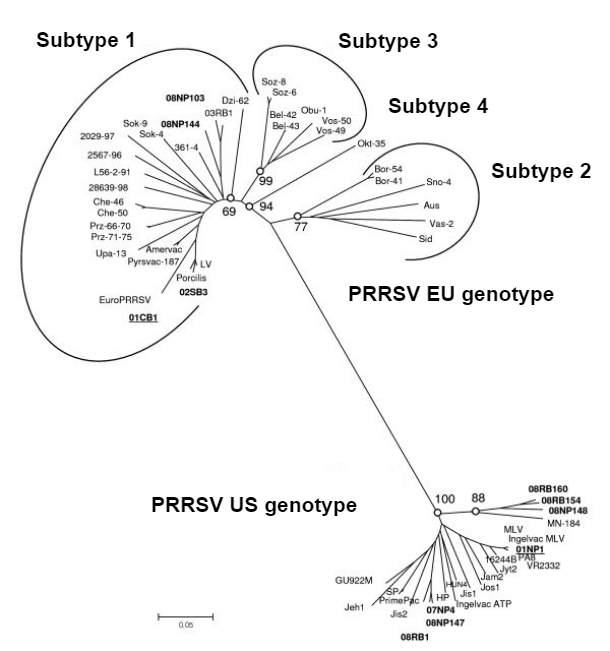An extensive career in PRRSV research
Dr. Hans Nauwynck, professor at Ghent University (Belgium) has an impressive and productive research career. He is author of more than 450 peer-reviewed articles, 3 book chapters, and 76 theses within the last 30 years. He is considered as one of the most important European researchers, for sure the most energetic one! In this article we summarize our discussions with him about how PRRSV has been evolving in the field over time.

PRRSV Type 1 related problems
Early in his career ('90s), he performed experiments to examine the behavior of PRRSV-1 and PRRSV-2 strains. Although both were inducing reproductive failure in sows they were completely different at the level of the respiratory tract in young pigs. Respiratory distress was evident with type 2. Type 1 strains mainly caused subclinical infections. Those years he learned that in the EU we were dealing with a totally different virus compared to the US/Canada. The strong genetic difference agreed with the clinical findings (Image 1). The field experiences were also very different. With the PRRSV-1 strains, the virus was spreading extremely slow in the finishing unit. It took a whole finishing period for the virus to infect all pigs. This was pointing to a very inefficient transmission power. A faster spread was experienced with PRRSV-2. In the US, scientists demonstrated an aerogenic spread. In the '00s, genetically deviating PRRSV-1 strains were identified in Russia/Belarus (subtypes 2 and 3) that were much more virulent and pathogenic. More recently, PRRSV-1 subtype 1 is spreading faster and is even causing overt disease (Italian strains).

“In Western Europe, you do not have to worry about PRRSV type 1 as a pathogen for respiratory problems; you need to fear and pay attention to the associated diseases or co-infections”, says Dr. Nauwynck. He designated the PRRS related respiratory problems in the EU, “PRRS PLUS” (he launched this term for the swine field vets) (Image 1). The multiple PRRSV co-infections with different other pathogens make of PRRSV one of the most important pathogens in the EU. As a result, it is essential to have a deep diagnostic analysis. All pathogens should be identified. In this context new diagnostics are necessary. A full knowledge of circulating pathogens is important to understand what is going on at the farm and to control PRRS PLUS. As he says- “If veterinarians take care of all potential co-infections, the clinical respiratory signs of PRRS are mainly gone”. He believes that European positive farms can grow pigs very efficiently when controlling the cofactors and do not need to eradicate the virus. This can change of course when the virulence/pathogenicity of the virus increases in the future.
Virus evolution can be explained by a better knowledge of the virus-host interactions; the role of the Siglec receptors
His team is focusing on the study of virus-host interaction at a molecular level and as a result, they have been able to understand how the virus has been changing over time, especially how it increased its transmission power, as described above and its pathogenicity.
His team demonstrated that the virus entry in macrophages involves multiple steps. It starts with the interaction of the virus with siglec receptors and is followed upon internalization with the interaction with the CD163 receptor, leading to disassembly. Different siglecs can be used by PRRSV and evolved in time.
Siglec-10 can be hypothesized as the “arche-receptor”. Siglec 10 is present on a small subset of macrophages in tonsils and other lymphoid tissues and is very efficient in the virus entry process, demonstrating its long co-evolution with PRRSV. This siglec was most probably used in the very beginning of the emergence of the virus. At that time, PRRSV was only replicating in this small population of macrophages and was most probably not causing clinical signs. Because siglec-10 is also present on B-lymphocytes, PRRSV could bind and enter but did not infect these cells. This could be the basis of the persistence of the virus in its host (reservoir). At the end of the '80s, PRRSV most probably switched additionally to the Siglec-1 receptor (=sialoadhesin, CD169) (Image 2). Siglec-1 positive cells are present in the lungs, placenta, lymphoid tissues. The replication in the lungs and placenta resulted in respiratory and reproductive problems. That was the basis for the name PRRSV. In the '00s, the virus in Western Europe started to replicate in the nasal macrophages, which led to an increase in transmission between pigs. The receptor that is responsible for this adaptation is not known; it is different from Siglec-1 and Siglec-10. The highly virulent Lena strain (PRRSV-1 subtype 3) is causing vessel pathology, which is associated with the replication of PRRSV in venous macrophages. The receptor in this subset of macrophages is also different from Siglec-1 and Siglec-10. The receptors in the nasal and venous macrophages are under investigation.
He believes that the virus keeps evolving towards forms that infect more and more subpopulations of macrophages.








